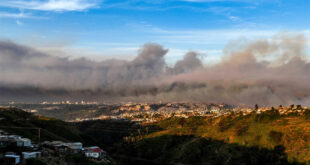China on Thursday slammed what it called “provocative” moves by the United States and its ally the Philippines in the South China Sea, as both sides held drills in the waters.
Warships from China and the U.S. conducted rival exercises in the sea this week amid heightened tensions involving U.S. ally the Philippines.
Beijing’s People’s Liberation Army (PLA) Southern Theater Command Wednesday said a two-day deployment of its navy and air force, scheduled to end today, was carrying out “routine patrols” in the sea.
It did not mention where exactly the patrols took place or give specific details of the goals of the exercises.
They took place as the United States said an aircraft carrier strike group led by the USS Carl Vinson was conducting two days of drills with the Philippine Navy.
Beijing condemned those manoeuvres as “provocative military activities” aimed at “flaunting their military might.”
Foreign ministry spokesman Wang Wenbin said the exercises were “detrimental to management and control of the maritime situation and related disputes.”
“We urge relevant countries to stop their irresponsible actions and earnestly respect the efforts of countries in the region to maintain peace and stability in the South China Sea,” he said.
Beijing, he pledged, would “continue to firmly safeguard its territorial sovereignty and maritime rights and interests.”
Beijing claims almost the entire South China Sea and has ignored an international tribunal ruling that its assertions have no legal basis.
It deploys boats to patrol the busy waterway and has built artificial islands that it has militarized to reinforce its claims.
And while China typically uses its coast guard to enforce its claims in the area, military exercises are not uncommon, with Beijing’s navy conducting “routine” drills in late November.
Footage from Chinese state broadcaster CCTV showed what Beijing called a “live fire drill,” with aircraft flying over the seas and one jet firing a missile.
Projecting presence
This week’s drills follow a month of tense standoffs between China and the Philippines in disputed reefs in the area that saw a collision between vessels from the two countries and Chinese ships blasting water cannons at Philippine boats.
One expert told AFP that Beijing was seeking to turn the South China Sea “into a Chinese-controlled waterway and a strategic chokepoint for other countries.”
“The South China Sea is becoming… a key defensive zone for China,” Michael Raska, assistant professor and military expert at Singapore’s Nanyang Technological University, said.
Beijing is also using the area to test “reconnaissance and surveillance,” he said, deepening its ability to “project presence and influence in the sea.”
“While China routinely dispatches warships to shadow U.S. aircraft carriers in the South China Sea and to monitor multilateral military activities in the region, the public announcement of such an exercise is very rare,” Duan Dang, a Vietnam-based maritime analyst focusing on the South China Sea, told AFP.
‘Resolute measures’
China this week insisted the Philippines was to blame for the spike in tensions, with the foreign ministry saying Manila had “reneged on its words, changed its policy, infringed on China’s sovereignty and made provocations again and again and triggered complex situations.”
“China will take resolute measures against any violation of our sovereignty and provocation, and firmly safeguard our territorial sovereignty and maritime rights and interests,” ministry spokeswoman Mao Ning said on Dec. 29.
This week’s drills also follow the appointment of Dong Jun — a former navy chief and deputy commander of the Southern Theater Command — as Beijing’s defense minister.
Sheena Chestnut Greitens, an expert in Chinese politics, told AFP that Dong’s background in “important areas of military tension” and as a naval official may have played a role in his promotion.
“He has operational experience and background in the challenges presented by Taiwan, the South China Sea and the East China Sea,” she said.
Vietnam calls the South China Sea the East Sea.
- Reduce Hair Loss with PURA D’OR Gold Label Shampoo
- Castor Oil Has Made a “Huge” Difference With Hair and Brow Growth
- Excessive hair loss in men: Signs of illness that cannot be subjective
- Dịch Vụ SEO Website ở Los Angeles, CA: đưa trang web doanh nghiệp bạn lên top Google
- Nails Salon Sierra Madre
 VnExpress News The News Gateway of Vietnam
VnExpress News The News Gateway of Vietnam




